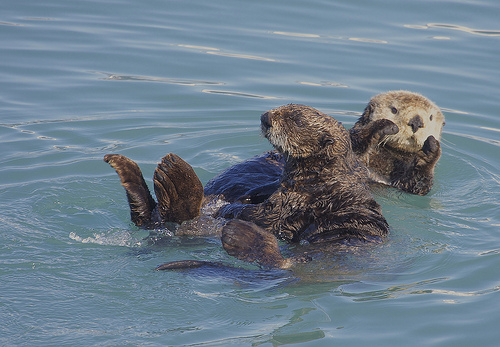Sea otters are very unique and affectionate animals.
- Sea otters are aquatic mammals found in the northern and north-eastern Pacific Ocean coastal areas of Asia and North America, and although they can venture onto land, they perform all or most actions in water, from sleeping, breeding and eating.
- Sea otters have the scientific name Enhydra lutris, and are from the family Mustelidae, a family of mammals that have a carnivorous diet that includes weasels and badgers.
- Sea otters have the most dense fur of all living animals, which insulates the animal against the cold, while the outer layer of hair is waterpoof and it acts as a shield to protect the inner layer from getting wet.
- Sea otters have a lifespan of up to 23 years, but on average they live up to 10 to 20 years, and they grow to be 1 to 1.5 metres (3.3 to 4.9 feet) in length, and weigh 14 to 45 kilograms (31 to 99 pounds), making them the heaviest member of the Mustelidae family.
- Sea otter’s fur is coloured dark brown, black, brown-grey or yellow in colour, and is occasionally speckled with a silver colour.
Northern Sea Otters
Image courtesy of Gregory Smith/Flickr
- Sea otters can swim submerged at a rate of 9 km/h (5.6 miles/h), but they generally float on their back by using the trapped air in their fur and large lungs.
- Sea otters use their whiskers to sense underwater movement, along with their good sense of smell, as well as their vision and hearing abilities, and their diet mainly consists of fish, crustaceans, sea urchins and molluscs.
- Sea otters spend much of their time sleeping by floating on their backs in water, and grooming, which increases the air capacity of their fur, their floating ability, the fur’s water repelling ability, and protection from cold.
- Female sea otters generally have a single pup per litter, that is treated with much affection and attention, and any extra pups are generally abandoned.
- Sea otters remain endangered, due to the mammal almost being obliterated by human hunting from 1741 to 1911 for their valuable fur, causing the world population to drop from 150,000 – 300,000 down to 1,000 – 2,000 animals, and since they have been protected in various capacities since 1911, the population has somewhat recovered with 100,000 – 150,000 animals that now exist.
Bibliography:
Sea Otter, 2014, National Geographic, http://animals.nationalgeographic.com.au/animals/mammals/sea-otter/
Sea Otter, 2014, Wikipedia, http://en.wikipedia.org/wiki/Sea_otter







